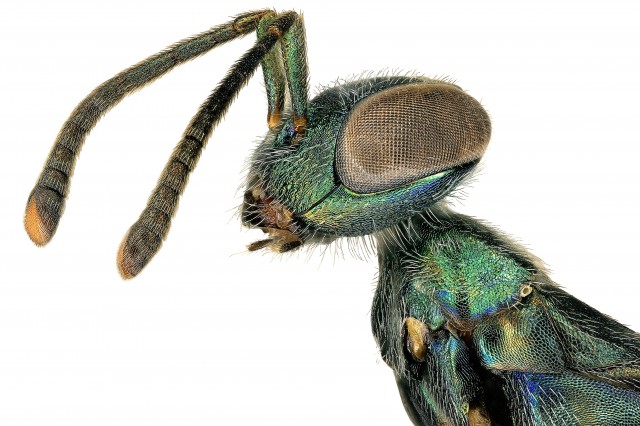Spiders in the House
Awe-inspiring or awfully scary? NHM’s arachnid educators are standing by in our seasonal exhibit, the Spider Pavilion, ready to unspool the truths about these web spinners with tangled reputations.
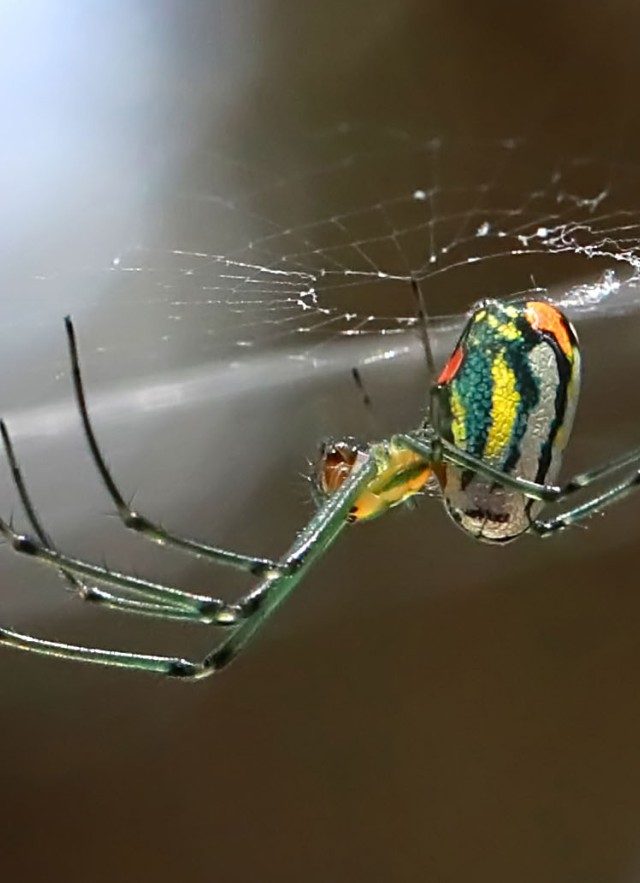
Published October 5, 2023
As visitors enter this sun-filled garden, knowledgeable Museum Educators will point out the artistry of the eight-legged architects who can build homes in the shape of funnels, zig-zags, and giant orbs engineered to stretch six feet long. The light-dappled tent over the season will be home to more than 500 spiders—about 30 species—from local SoCal beauties to species that spin their webs around the world. Spiders come in many shapes and sizes—from this year’s big star, the Joro spider (Trichonephila clavata), all the way down to the spinybacked orbweaver (Gasteracantha cancriformis), which looks like a little Pokemon and is the size of an M&M.
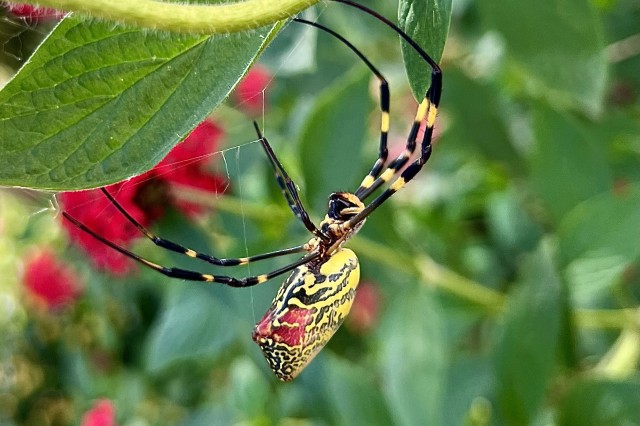
Joro spiders (Trichonephila clavata) are a brand-new species of orbweaver that we are featuring in the Spider Pavilion this year! These large, spectacular spiders are originally from Asia but have been recently introduced into the United States over the past 10 years.
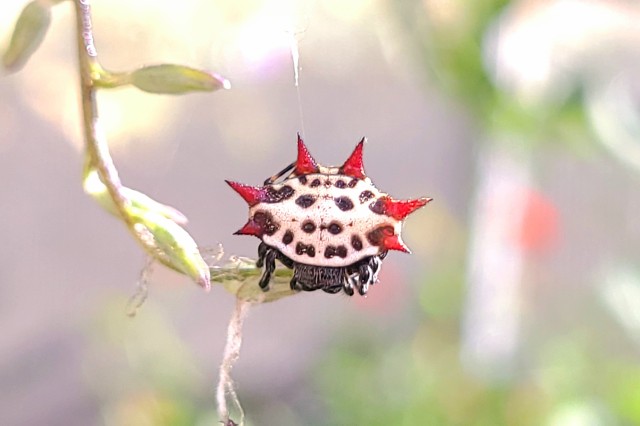
Tyler Young
The spinybacked orbweaver (Gasteracantha cancriformis) is a living Pokemon. It is the smallest orbweaver featured in the Spider Pavilion; about the size of a button, and as cute as one, too!
1 of 1
Joro spiders (Trichonephila clavata) are a brand-new species of orbweaver that we are featuring in the Spider Pavilion this year! These large, spectacular spiders are originally from Asia but have been recently introduced into the United States over the past 10 years.
The spinybacked orbweaver (Gasteracantha cancriformis) is a living Pokemon. It is the smallest orbweaver featured in the Spider Pavilion; about the size of a button, and as cute as one, too!
Tyler Young
Lucky visitors may catch the Museum’s Living Collections staff pampering these colorful residents (gourmet lunches are hand-delivered three times a week to their flowering plant perches.) Guests may even spot an egg sac or two dangling from the branches of a leafy bush, the temporary quarters of the next generation. For Lisa Gonzalez, Program Manager of the Living Collections who oversees the Pavilion, running this spider spa is a childhood passion realized.
“As a child, I was really into animals, in general. Which animals are the most accessible for the vast majority of people in the world? Most of us live in cities, right? So you go out in your backyard and you're not seeing these large animals, you're seeing small animals like insects and spiders… that was what was accessible for me when I was little.” Gonzalez knows that not everyone is equally enamored—and a good number of humans are frightened by these creatures—but she is practiced at listening with empathy. “Oftentimes people just need a minute to share why they're afraid and what they know, or what their experience was that led to that. I ask them if they feel comfortable sharing with me, what about spiders worries them, and then I tell them what I know.”
“I've always been interested in animals that are different from us, and really mysterious. When you have to dig deeper to figure out how to decipher spiders' body language, that detective work excites me,” Lisa Gonzalez, who oversees the Spider Pavilion.
The trepidation is sometimes related to their “weird” anatomy, which she finds fascinating. “Our human brains are hardwired to see faces. So if we're looking at something like an insect or a spider, and we can't even figure out which end is the head end, that could be very unsettling for people.” The truth is that spiders are very shy animals, and are going to sit in their web (rather than chase prey on the ground as portrayed in some horror films.) “They're not aggressive, and even if anything accidentally gets too close to them, they run and hide. They really are big scaredy-cats.”
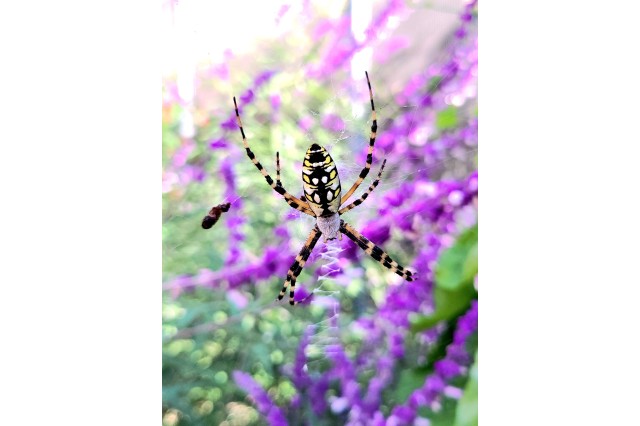
Tyler Young
The yellow garden spider (Argiope aurantia) is one of the larger orbweavers that can be found in Los Angeles County. Their webs are typically built in shrubs around waist-height, and often feature a distinct zig-zag pattern called a “stabilimentum.”
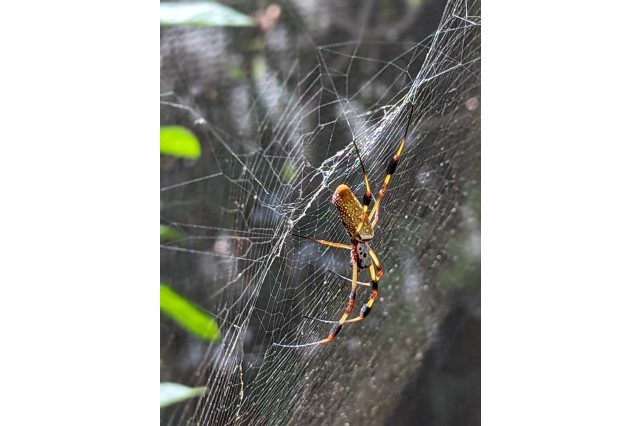
The golden silk orbweavers (Trichonephila clavipes) are a fan favorite of the Spider Pavilion. Their mustard yellow coloration and golden webs shining in the sun elicit “oohs and ahhs” from our visitors.
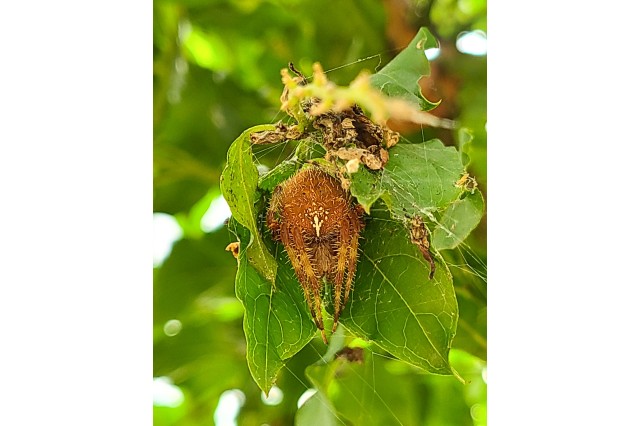
Kay Lai
Nestled safely in a little nook of leaves, the jeweled orbweaver spider (Aranues gemma) looks like a miniature Halloween pumpkin. This L.A. native is harder to spot than other orbweavers because they wait on the sidelines rather than the center of their webs.
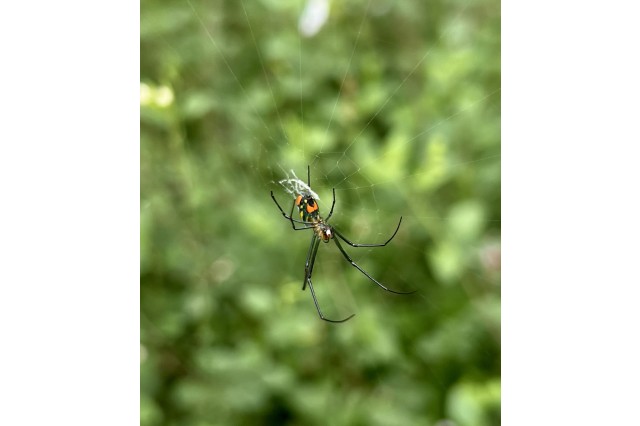
Becca Prater
The delicate orchard spider (Leucauge venusta) is a small orbweaver that feeds on tiny flies like fruit flies and mosquitoes. With a complex pattern of reds, yellows, and greens, it is one of the more colorful spiders in the Pavilion.
1 of 1
The yellow garden spider (Argiope aurantia) is one of the larger orbweavers that can be found in Los Angeles County. Their webs are typically built in shrubs around waist-height, and often feature a distinct zig-zag pattern called a “stabilimentum.”
Tyler Young
The golden silk orbweavers (Trichonephila clavipes) are a fan favorite of the Spider Pavilion. Their mustard yellow coloration and golden webs shining in the sun elicit “oohs and ahhs” from our visitors.
Nestled safely in a little nook of leaves, the jeweled orbweaver spider (Aranues gemma) looks like a miniature Halloween pumpkin. This L.A. native is harder to spot than other orbweavers because they wait on the sidelines rather than the center of their webs.
Kay Lai
The delicate orchard spider (Leucauge venusta) is a small orbweaver that feeds on tiny flies like fruit flies and mosquitoes. With a complex pattern of reds, yellows, and greens, it is one of the more colorful spiders in the Pavilion.
Becca Prater
On a recent afternoon, Gonzalez and two of the Living Collections staff team visited the Pavilion to release new residents. They scanned the space and monitored the silky webs to make sure there’s ample room between branches for optimal web-spinning potential. If a spider is constructing its home on top of another arachnid’s pad (spiders sometimes eat each other!), it will be carefully relocated. The team members pop open plastic bins and manually guide the spiders to their green digs.
Eric Villalvazo, a Living Collections Specialist, is bringing out waxworms for a late-afternoon feeding. He gingerly flings a yellow bug into one glistening translucent spiral. The golden silk orbweaver (Trichonepila clavipes), suspended in its yellow-tinted web, is distinguishable by its fuzzy “leg warmers.” Close by, the Joro spider, hanging upside down by its hook-like leg on an impressively large web, is next. Its lime-green-and-yellow body scoots up towards its supper.
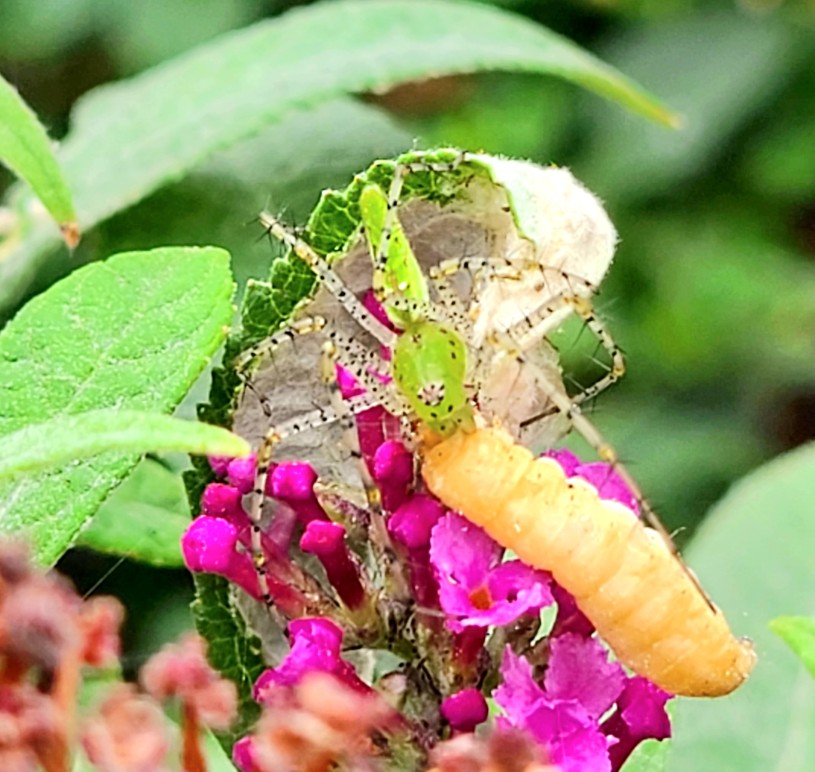
“That worm is a good food source to feed. Normally, they'll be eating stuff that's flying by…We give them wax worms because they're light and easy to grab, and they're really hardy as well. So it's a good source of protein. And it's really easy to not break their webs or mess them up too much.” Meanwhile, visitors walk along the path taking photos of the gawk-worthy beauties, like spider paparazzi.
“Usually, when you think of people who are taking care of animals, it’s mammals, birds, or fish in an aquarium. But you don't often think about people whose job is to take care of spiders and insects,” says Gonzalez. “We're treating and caring for these animals in the same way that we're caring for the snakes, birds, and the turtles that live here [at the museum]. Our spiders are very well-cared for and very loved.”

